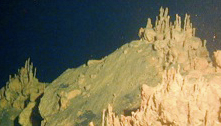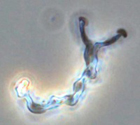|
 Loihi underwater landscape Loihi underwater landscape
showing Fe-oxide carpet Microbial cells
Microbial cellsLoihi Seamount is a hydrothermally active seamount in the mid-Pacific ocean
where waters containing high concentrations of reduced iron exit the Earth's
crust and where massive amounts of volcanic rock come in contact with sea water.
Here abundant iron-oxidizing bacteria, in the darkness of the deep sea, carpet
the rock surfaces, forming rust coatings on massive areas of the seamount's
surface. The bacteria form microbial mats and crusts on exposed rock surfaces
and greatly accelerate the alteration of these rocks.
In turn, the rust (iron oxide) impacts other microorganisms and affects
elemental cycling on the planet. Processes such as these are probably widespread
in deep dark environments where water circulates below the surface of land and
the oceanic crust.
The focus of the
Fe-Oxidizing Microbial Observatory (FeMO)
project is to
understand who the important iron-oxidizing bacteria in the environment are, how
fast they form iron-oxide deposits, how they do it biochemically, and how they affect ocean chemistry and ecosystem function. Our team selected the
Loihi Seamount because it affords the maximal cross-section of diverse habitats over a minimal spatial scale, from low-flow, low-temperature environments to high-flow, high-temperature environments,
including basaltic rock habitats.
|